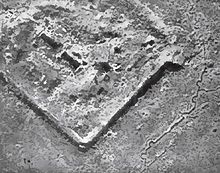Fort de la Malmaison
The Fort de la Malmaison (also called Fort Dumas for a short time ) in the municipality of Chavignon (Département Aisne) was a barrier fort of the Système Séré de Rivières , which was built between 1878 and 1882. It belonged to the belt around the Laon fixed place .
designation
Originally it was called Fort de la Malmaison . By Presidential Decree of 21 January 1887, the Minister of War sat Georges Boulanger that all forts, fortified artillery installations and barracks were the Système Séré de Rivières to bear the name of former military commanders, the fort which is why after the revolution General Anne Joseph Dumas called Fort Dumas received . On October 13, 1887, this was reversed by Boulanger's successor, Théophile Ferron, with Note No. 14980 of the same date, and the fort was given its original name back.
description
It was built as a result of the lost war against Germany and the associated border shifts to the west. Construction began on September 1, 1878, and was completed in 1882.
The Fort de la Malmaison covered the roads to Soissons and Laon , on this the last obstacle for an attacker on the way to Paris. It was supported by the forts Condé and Montbérault.
- War occupation:
22 officers, 46 NCOs, 736 men: a total of 804 men
- Ammunition supply:
2 powder magazines for 120 tons of black powder , magazines for 500,000 cartridges , 1 powder laboratory
- Food supply:
2 ovens with a capacity of 300 loaves per day each, 2 wells with a capacity of 18.3 m³ each per day, 1 cistern with a capacity of 60 m³
- Others:
1 sick bay with 80 beds, 1 stable for 14 horses
- Artillery equipment 1883:
On the ramparts:
- 5 canons de 155 mm L modèle 1877 , 17 canons de 120 mm L modèle 1878 , 6 Mortiers lisses de 15
In the trenches:
- 4 Canon de balles ( grape guns ), 4 Canon Reffye de 85 mm (also referred to as "de Canon 7")
It was laid out in a rectangular shape, the trench was secured by two double capons (north-east corner and south-west corner) laid diagonally to the ground plan . The guns were placed on the gun placements, which were separated by hollow cross beams . They fired over bank, i. H. over the parapet. The core of the fort was surrounded by a wall, a moat with escarp and Contreescarpen wall and a glacis . There was a covered path in sections on the wall . The fort also had a light signal station for connection with the neighboring plants. A removable bridge led to the main entrance.
history
The fort at the end of the 19th century
Four years after its completion, the fort was used by the pioneers for testing purposes. It was about the effect of the newly introduced explosive shells on the forts, which were built of masonry without concrete roofing. In 1886 171 grenades of the "Canon de 155 L Modèle 1877" and the Mortier de 220 mm modèle 1880 were delivered to the fort. The result was clear, none of the fortifications built by 1870 could withstand the new type of ammunition. It was therefore necessary to add concrete reinforcements.
No modernization measures were carried out on the structure, its combat value was downgraded on October 1, 1888, abandoned in 1911 and sold to a private person.
First World War
The fort was occupied by the Germans at the beginning of the war and fell back to the French in the course of the Battle of Malmaison on October 23, 1917. During the Battle of the Aisne , it fell into the hands of the Germans again on May 28, 1918 ( 7th Army ), but was finally left to the French on September 28, 1918 during the Second Marne Battle and by the 28 e bataillon de chasseurs alpins (28th Mountain Infantry Battalion ) occupied. It was largely destroyed during the fighting.
Memorial
The remains of the fort can be visited with a guide from the Caverne du dragon museum. Free access is not permitted.
The German military cemetery Fort de Malmaison is located on the neighboring site of the fort .
Web links
- Le fort de la Malmaison ou Fort Dumas in Fortiff'Séré
Footnotes
- ↑ Note No. 5285 of March 25, 1886 from Minister of War Général Boulanger to the General Commanders of the Military Regions; Presidential decree of January 21, 1887 renaming the forts, fortified artillery systems and barracks, as proposed by the Minister of War, Général Boulanger.
- ↑ 15 cm bronze mortar from 1838 for firing spherical bombs filled with black powder.
- ^ Liaison optique et poste optique in Fortiff'Séré
Coordinates: 49 ° 27 ′ 40 ″ N , 3 ° 31 ′ 21 ″ E

